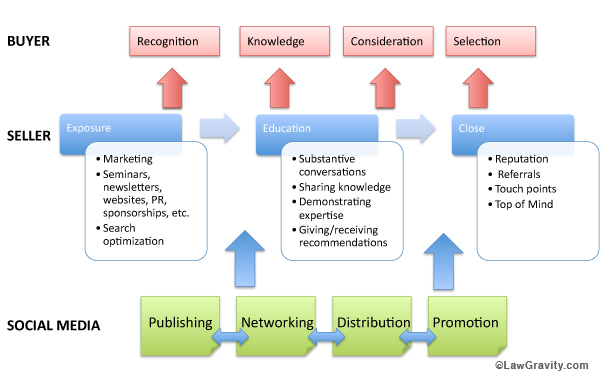Are you still trying to get your arms around social media? Still feeling uncertain about it’s usefulness in marketing your practice or for networking your referral sources?
You’ve probably attended webinars, conference sessions, read whitepapers, articles, blog posts, and maybe even books, to try to find the most simple, direct answer to “what should I be doing?” And, you might even have come up slightly more overwhelmed, right? May I suggest that you…
Establish context.
I’ve spent the last three years speaking on social media to groups of lawyers, marketers, law firm administrators, and more, watching eyes glaze over densely illustrated slide decks with dizzying screen captures of sites and services. I’ve gotten my share of unsettling looks from the risk averse when covering the issues of privacy, policy, ethics, and other do’s and don’ts. I’ve fielded hundreds of questions from lawyers and marketers, only to realize that I’ve created more questions than I answered for them. Truth is, I study this stuff, it’s my JOB, and even I am often challenged by the unstructured nature of social media.
I determined to fix that. Social media needs a little more structure. To that I said, ahaha! CONTEXT. We need context. Context gives structure to plans, why not social media. So, if you’re tired of the buck shot approach and want to give your social media experience a little more structure…read on….there’s only one step…
1. Don’t do anything different.
Keep doing what you’ve always done (either consciously or unconsciously) when originating or expanding on business—help the buyer through the purchase process. That process of buying services hasn’t changed since the first day that the very first service was bartered or bought.
Whenever there is a high involvement purchase, you can be certain that the buyer WILL pass through these four phases:
- Recognition
- Knowledge gathering
- Consideration
- Selection
Your job as an attorney is easy; help the buyer through the stages.
The Buyer’s Process.
1. Recognition – the buyer seeks to recognize their options; i.e., “Who can help me set up a trust fund for my kids?” Now, without being aware that you, an estate-planning attorney, exist, how can they hire you? They can’t. You have to have exposure. Marketing your practice via things like advertising, sponsorship, speaking, writing, website optimization, or word-of-mouth (referrals) are all good ways to “help buyers” who are looking for your services to find you. (I used the estate-planning example here, which is more B2C, but it is really the same, or similar, for B2B practices as well.)
2. Knowledge gathering – Once the buyer feels confident that they have sufficiently identified a manageable universe of attorneys they will move into the knowledge gathering phase. This is where they start talking to others, ask for specific reasons why they are recommending so and so, AND, they do an Internet search to learn more about you, as well as learn as much as they can about their options—your competition. (Give them lots to look at! Give them more than the one-dimensional website bio page!)
This is the stage where you need to stand out from the others. You can differentiate your self by carefully listening for the real needs then offering proof of your expertise in that regard. Or, you can maintain a high profile reputation among those who can recommend you. You can also differentiate by providing educational content through publishing articles and, hopefully you’ll be able to engage directly with the buyer through substantive conversations while having a get-to-know-you with them. In this phase remember, you are not selling, you are educating – but really you are closing the engagement – more on that coming up!
3. Consideration – When the buyer determines that they have enough information, they make a short list and enter the consideration phase. This is when they analyze the pros and cons of each attorney based upon what they uncovered during the knowledge gathering stage. If you, the seller, have been helpful in the knowledge gathering stage, you may also be invited to the consideration stage.
In the consideration stage it is your job to stay top of mind with the buyer, dig deeper into their thought process and fill in any gaps or doubts. Manage this stage well and you increase the likelihood that their selection is YOU!
4. Selection – If you did everything right in the knowledge gathering stage, and helped them through the consideration stage, you have already closed the engagement.
SOCIAL MEDIA.
In the context of the buyer-seller processes use social media — social media gives you ample opportunity to hit all the phases: recognition, education, consideration and selection.
First, get to know which social media serves best in each phase, then use it! For example, having a search footprint that is full of content links – not just those that lead to your firm website bio – is great for exposure. And, if some of those links lead to published content that serves to educate the buyer, not only about your services but also about your topics, you will be helping the buyer through the knowledge gathering phase. Then, if you add value to conversations, post questions and answers, participate in groups, network on Facebook, etc., you’ll not only address the knowledge-gathering phase; you’ll be keeping your name top of mind during the consideration phase. And the beauty of it all is that your online footprint keeps working for you even when you’re sleeping, or playing. Further, online content spreads and there by increases your exposure to new prospects, again, filling in the beginning recognition phase of the process.
Make sense? Hope this helps you in your knowledge gathering stage…let me know!
As always, standing by to help you grow your practice via social media, and more…






